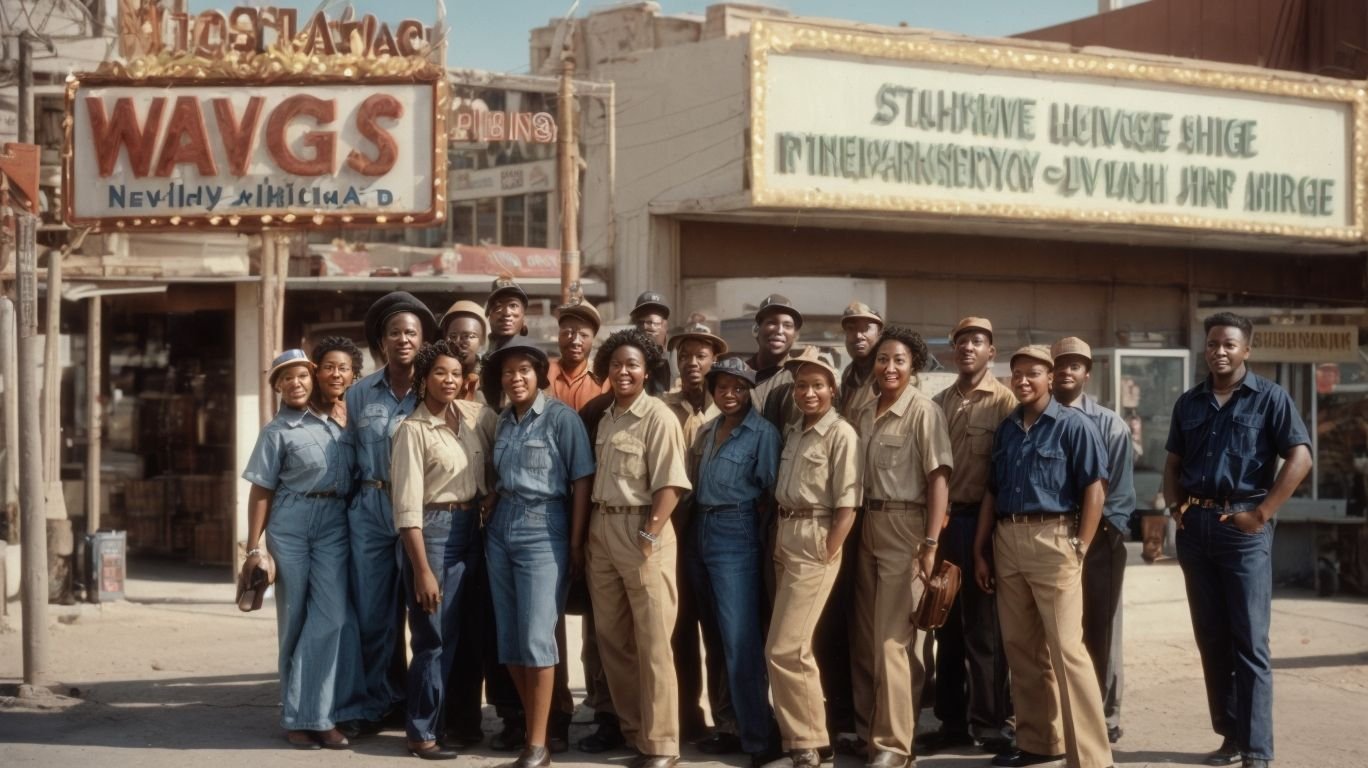Nevada’s Minimum Wage Triumph is a significant achievement for low-wage workers in the state. It is a legislative action that will gradually increase the minimum wage to $12 per hour by 2024, benefiting nearly 300,000 workers in the state. This triumph is a result of years of effort and advocacy by grassroots organizations and community leaders.
Nevada’s success in achieving this milestone can be attributed to two main factors – legislative action and grassroots campaigns. In 2020, the state legislature passed a bill to increase the minimum wage, and later that year, the majority of voters approved a constitutional amendment to raise the minimum wage. This dual approach was critical in achieving the necessary support and momentum for this triumph.
The benefits of Nevada’s Minimum Wage Triumph are numerous and far-reaching. Here are three significant advantages of this achievement:
- Increased Income for Low-Wage Workers: With the gradual increase in the minimum wage, low-wage workers will see a significant increase in their income, providing them with financial stability and a better standard of living.
- Reduced Poverty and Income Inequality: The increased minimum wage will lift many workers out of poverty and reduce income inequality, making Nevada a more equitable state.
- Boost to Local Economy: Higher wages means more money in workers’ pockets, leading to increased consumer spending, which in turn, boosts the local economy.
While Nevada’s Minimum Wage Triumph is a significant success, there are potential challenges that the state may face in implementing it. These challenges include resistance from businesses, the impact on small businesses, and inflation and the cost of living. However, with proper planning and policies, these challenges can be addressed and mitigated.
Other states can learn valuable lessons from Nevada’s triumph. Three key takeaways are:
- Importance of Legislative Action: Legislative action is critical in achieving significant reforms, such as increasing the minimum wage. States should prioritize such actions to support their workers.
- Power of Grassroots Campaigns: Grassroots organizations and community leaders played a pivotal role in advocating for this triumph. Their efforts and perseverance can serve as an inspiration to other states.
- Balancing Economic Growth and Worker Rights: Nevada’s success is a perfect example of how states can balance economic growth and worker rights. By increasing the minimum wage, the state is promoting economic stability and equity for its workers.
Key Takeaways:
What Is Nevada’s Minimum Wage Triumph?

Photo Credits: Humanresources-Hr.Com by Jeremy Lee
Nevada’s minimum wage triumph refers to the successful implementation of a significant raise in the state’s minimum wage, which aims to address income inequality and improve the standard of living for workers in Nevada.
The triumph can be traced back to 2024 when the state legislature approved a substantial increase in the minimum wage, providing workers with better compensation and increased financial stability.
How Did Nevada Achieve This Success?

Photo Credits: Humanresources-Hr.Com by Juan Davis
In 2024, Nevada will see a significant increase in its minimum wage, surpassing the federal minimum by over $3. This success did not happen overnight, but through a combination of legislative action and grassroots campaigns. In this section, we will take a closer look at how Nevada achieved this milestone, diving into the key factors of legislative action and grassroots campaigns. By understanding the strategies and efforts behind this success, we can gain valuable insights for future minimum wage campaigns.
1. Legislative Action
- Research existing laws and precedents regarding minimum wage.
- Identify key stakeholders and build alliances for support.
- Draft a comprehensive legislative proposal with clear objectives and benefits for all parties involved.
- Conduct thorough economic impact assessments and gather data to support the proposed changes.
- Negotiate and collaborate with various interest groups to address concerns and refine the legislation.
Nevada’s legislative action on minimum wage involved extensive collaboration and data-driven decision-making.
2. Grassroots Campaigns
- Build a strong network: Establish connections with local community leaders, organizations, and volunteers to support the cause of grassroots campaigns.
- Educate and mobilize: Raise awareness about grassroots campaigns through workshops, seminars, and social media campaigns.
- Raise public support: Organize rallies, public events, and signature drives to gather support from citizens and stakeholders for grassroots campaigns.
Engage with local media to amplify the message of grassroots campaigns and gain public attention. Collaborate with like-minded movements to strengthen the impact and create a unified voice for change in grassroots campaigns.
What Are the Benefits of Nevada’s Minimum Wage Triumph?

Photo Credits: Humanresources-Hr.Com by Jeffrey Williams
Nevada’s recent minimum wage triumph has brought about numerous benefits for the state and its residents. In this section, we will discuss the positive impacts that this change has had on the lives of low-wage workers, including increased income and improved financial stability. We will also explore how this success has contributed to reducing poverty and income inequality in Nevada. Lastly, we will examine the economic benefits that have arisen from this minimum wage increase, such as a boost to the local economy.
1. Increased Income for Low-Wage Workers
- Implement a minimum wage increase: Nevada passed legislation to raise the minimum wage, providing low-wage workers with a higher income.
- Index the minimum wage to inflation: Tying the minimum wage to inflation ensures that low-wage workers’ income continues to increase in line with the cost of living.
- Support training and education programs: Investing in programs that enhance skills and knowledge can enable low-wage workers to qualify for higher-paying jobs, further increasing their income.
Considering the success in Nevada, other states can learn from this triumph by prioritizing the economic well-being of low-wage workers and ensuring that their income reflects the evolving economy.
2. Reduced Poverty and Income Inequality
- The triumph of Nevada’s minimum wage has had a significant impact on the state’s economy by reducing poverty and income inequality. The increase in wages for low-wage workers has contributed to a more balanced and prosperous environment for all Nevadans.
- Similarly, a small town in Oregon also raised its minimum wage, resulting in reduced poverty and income inequality, leading to improved living conditions and greater financial stability for many local residents.
3. Boost to Local Economy
- Increased Spending: With higher incomes, low-wage workers contribute more to local businesses, providing a boost to the local economy and increasing sales and economic activity.
- Job Creation: As consumer demand rises, businesses may expand and hire more workers, directly stimulating the local economy and creating new job opportunities.
- Tax Revenue: Increased consumer spending leads to higher tax revenues for the state, supporting public services and infrastructure development and providing a boost to the local economy.
What Are the Potential Challenges of Nevada’s Minimum Wage Triumph?

Photo Credits: Humanresources-Hr.Com by Steven Martin
While Nevada’s recent minimum wage triumph has been celebrated as a victory for workers, it’s important to also consider the potential challenges that may arise as a result. In this section, we’ll take a closer look at the possible obstacles that could arise from this change. These include resistance from businesses, the impact on small businesses, and potential implications for inflation and cost of living. By examining these factors, we can gain a better understanding of the potential challenges that may need to be addressed in order for this triumph to truly benefit all involved parties.
1. Resistance from Businesses
- Educating businesses about the long-term benefits of increased wages and addressing any potential resistance.
- Providing support for businesses through tax incentives or subsidies to ease the transition and alleviate any concerns.
- Implementing gradual wage increases to allow businesses to adjust their financial plans accordingly and minimize any potential resistance.
2. Impact on Small Businesses
Nevada’s successful implementation of a higher minimum wage may present challenges for small businesses, affecting their operational costs and overall profitability. Adhering to the increased wage requirements may pose a strain on resources, especially for smaller enterprises with limited financial flexibility and staffing capacity.
It is important to note that small businesses make up 99.9% of all businesses in the US and play a vital role in promoting economic growth and creating job opportunities.
3. Inflation and Cost of Living
- Monitor Inflation Rates: Keeping a close eye on inflation rates helps in adjusting wages to maintain purchasing power.
- Adjust Living Wage: Regularly reassess the living wage to ensure it aligns with the cost of living and inflation rates.
- Economic Policies: Implement policies that address inflation and cost of living to stabilize the economy.
Did you know? In 2024, the inflation rate in Nevada remained below the national average, positively impacting the cost of living for residents.
What Can Other States Learn from Nevada’s Minimum Wage Triumph?

Photo Credits: Humanresources-Hr.Com by Eric Roberts
As the first state to successfully raise its minimum wage to $12 an hour in 2024, Nevada has set an example for other states to follow. But what can we learn from this triumph? In this section, we will discuss the key factors that contributed to Nevada’s success: the importance of legislative action, the power of grassroots campaigns, and the delicate balance between economic growth and worker rights. By examining these lessons, we can gain insight into how other states can achieve similar successes in improving the lives of their minimum wage workers.
1. Importance of Legislative Action
- Advocacy: Lobbying for fair wages through legislative channels.
- Policy Framework: Drafting laws to ensure minimum wage adequacy.
- Enforcement Mechanisms: Creating systems to monitor and ensure compliance.
States should prioritize legislative action to address the importance of minimum wage concerns. Establishing robust laws, supported by enforcement measures, can uplift low-wage workers and reduce income inequality.
2. Power of Grassroots Campaigns
Grassroots campaigns hold tremendous power in creating meaningful change, as seen in the successful minimum wage increase in Nevada. These campaigns allow for direct interaction with communities, raising awareness and gaining public support for necessary policy reforms. Utilizing tactics such as door-to-door canvassing and local events, grassroots efforts effectively communicate the needs of low-wage workers and highlight the positive impact of a higher minimum wage.
Pro-tip: When organizing grassroots campaigns, make use of diverse communication channels, including social media and community forums, to amplify your message and mobilize support.
3. Balancing Economic Growth and Worker Rights
When considering the balance between economic growth and worker rights, it is important for states to prioritize fair wages, worker protections, and sustainable economic development. By implementing legislative measures, states can ensure that workers receive equitable pay while also supporting and promoting business growth.
It is essential to encourage open dialogue between policymakers, labor representatives, and industry leaders in order to find solutions that benefit both workers and the overall economy.
Frequently Asked Questions
What is Nevada’s unique two-tiered minimum wage system?
Nevada’s minimum wage system has two tiers – a higher tier that requires employers to pay non-exempt workers at least $9.75 per hour, and a lower tier that allows employers to pay $8.75 per hour if they provide workers with employer-sponsored health insurance. This system was established through the Minimum Wage Amendment (MWA), which was approved by Nevada voters in 2006.
How does the two-tier system affect overtime pay and health benefits?
Nevada employees are entitled to weekly overtime when they work more than 40 hours in a traditional 40-hour week. However, there is an additional requirement that they must be paid time-and-a-half if they work more than 8 hours in a 24-hour period. Workers’ eligibility for daily overtime also depends on their hourly wage rate and whether they are offered qualifying health benefits.
What are the annual increases for the minimum wage in Nevada?
The state’s minimum wage rates increase in $0.75 increments each year until 2024. As of July 1, 2019, the minimum wage for businesses that offer qualified health benefits is $8.75 per hour, and for those that do not offer health benefits, it is $9.75 per hour. By 2024, the minimum wage will reach $16.875 per hour for businesses with health benefits and $15.375 per hour for businesses without health benefits.
How does Nevada’s minimum wage system differ from federal law?
Nevada’s minimum wage and overtime requirements are different from the federal Fair Labor Standards Act. For example, workers can be eligible for daily overtime even if they do not exceed 40 hours in a week, based on their hourly wage rate and whether they are offered qualifying health benefits. Employers with a multi-state footprint or new operations in Nevada may face challenges in aligning their policies with the state’s unique laws.
Why is it important for employers to stay updated and compliant with Nevada’s minimum wage and overtime laws?
Nevada’s minimum wage and overtime rates can change each year, making it crucial for employers to stay updated to avoid any potential legal issues. Seeking legal advice from experts, like Chelsea Latino, can help businesses ensure they are following the correct laws and treating their employees fairly.
How has Nevada’s two-tiered minimum wage system been received by employers and workers?
The system has been a success for both employers and workers. Employers have the option to pay a lower minimum wage if they provide health benefits, and workers are entitled to higher wages and overtime pay. In fact, a ballot initiative to eliminate the two-tier system was rejected by Nevada voters in the 2016 general election, with a 69% majority ratification.





